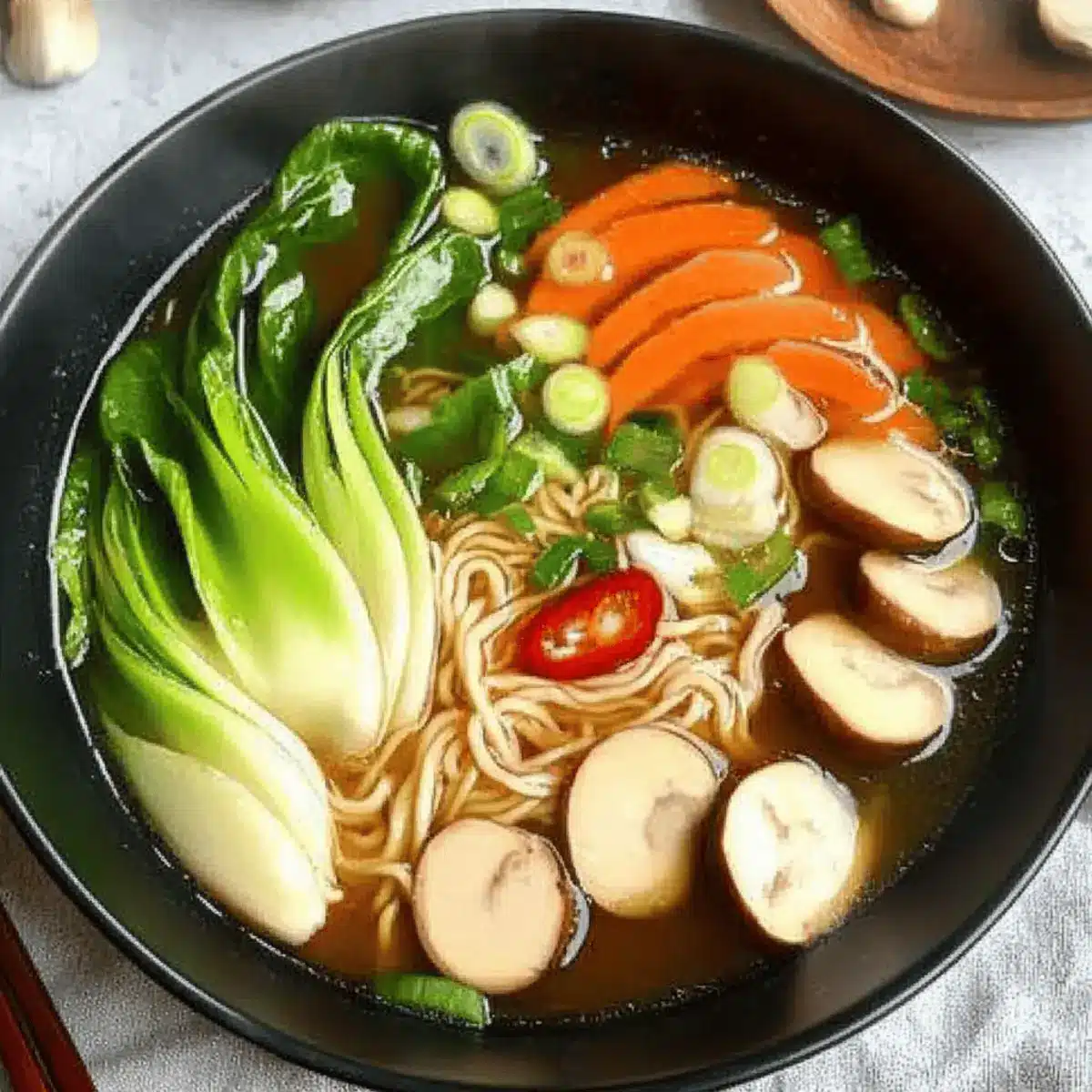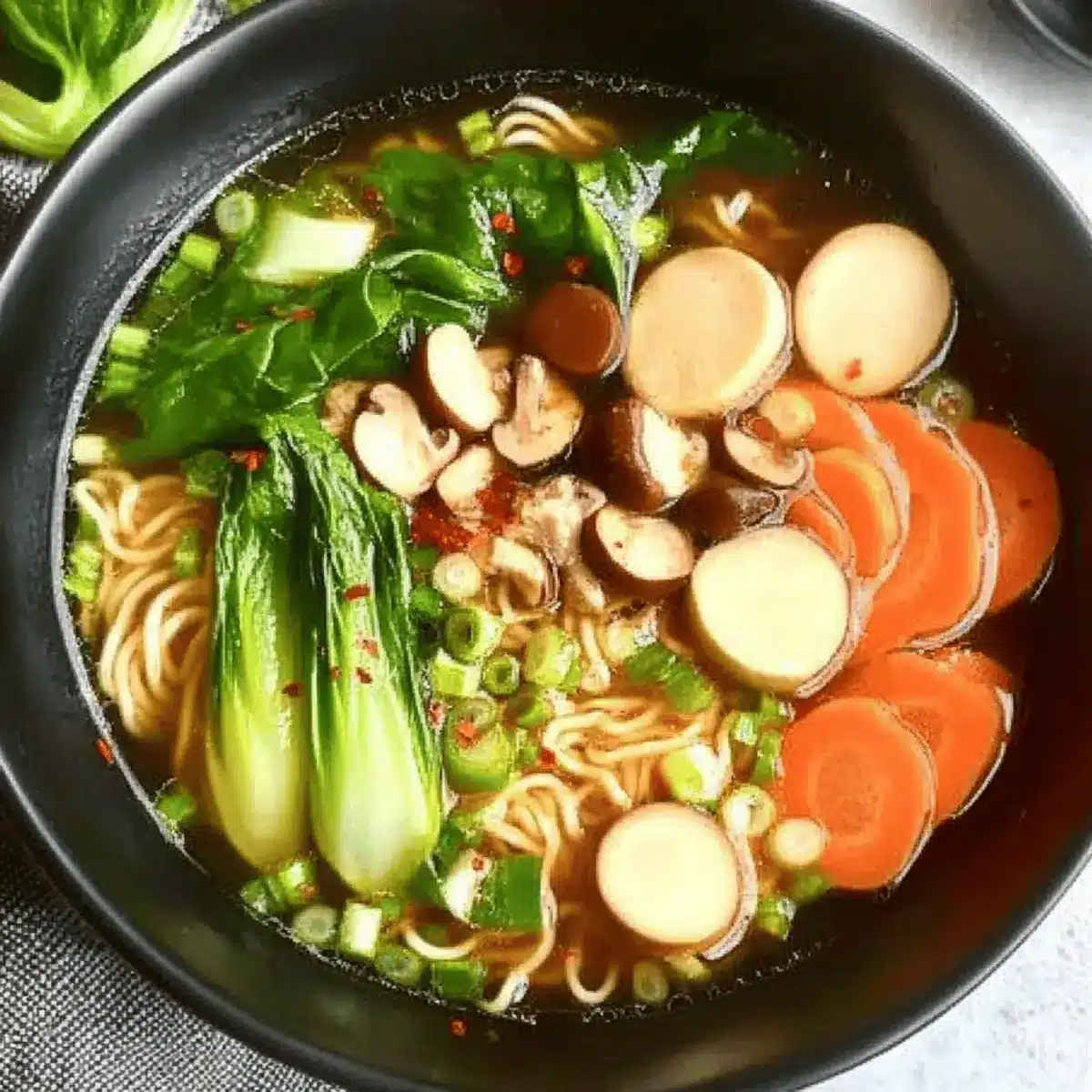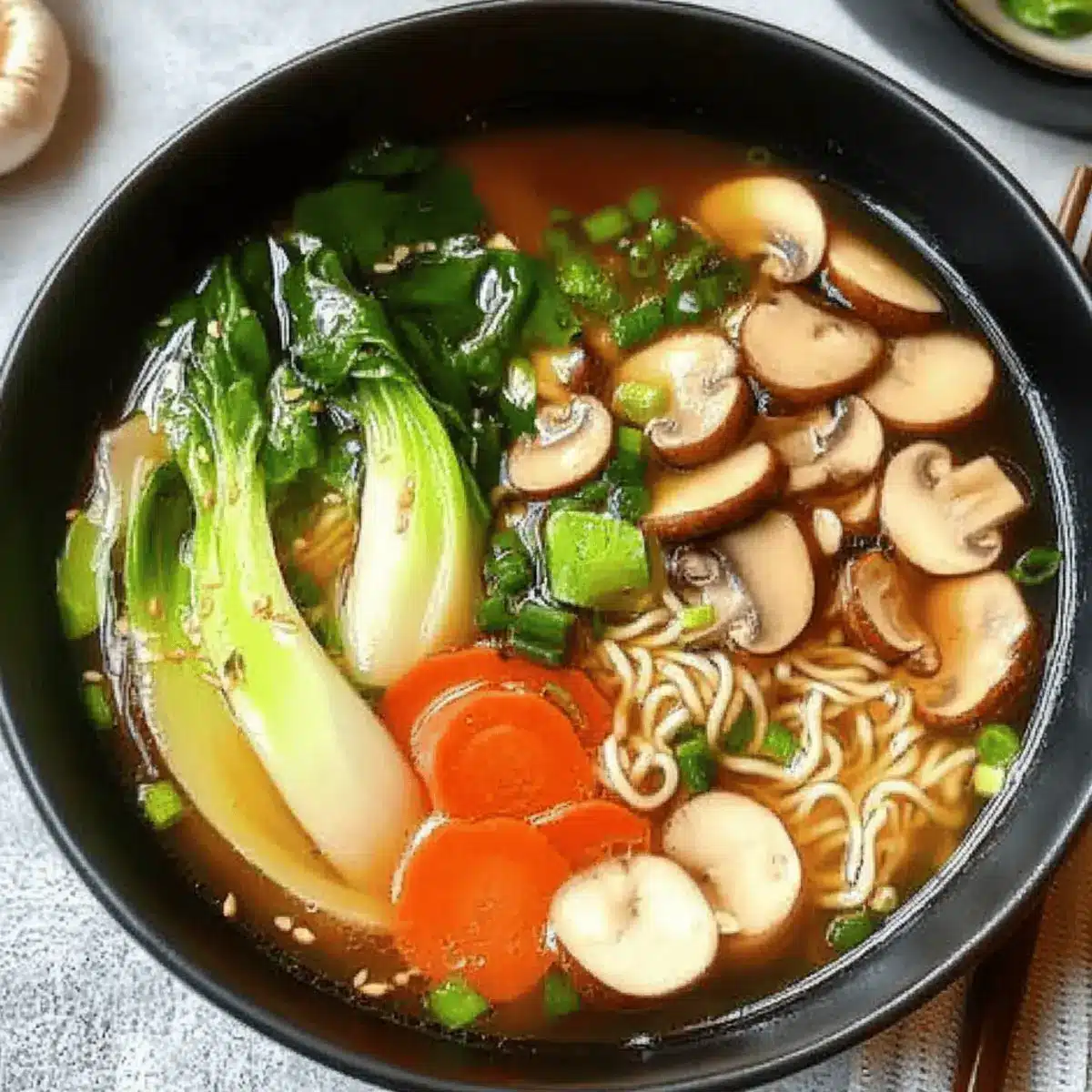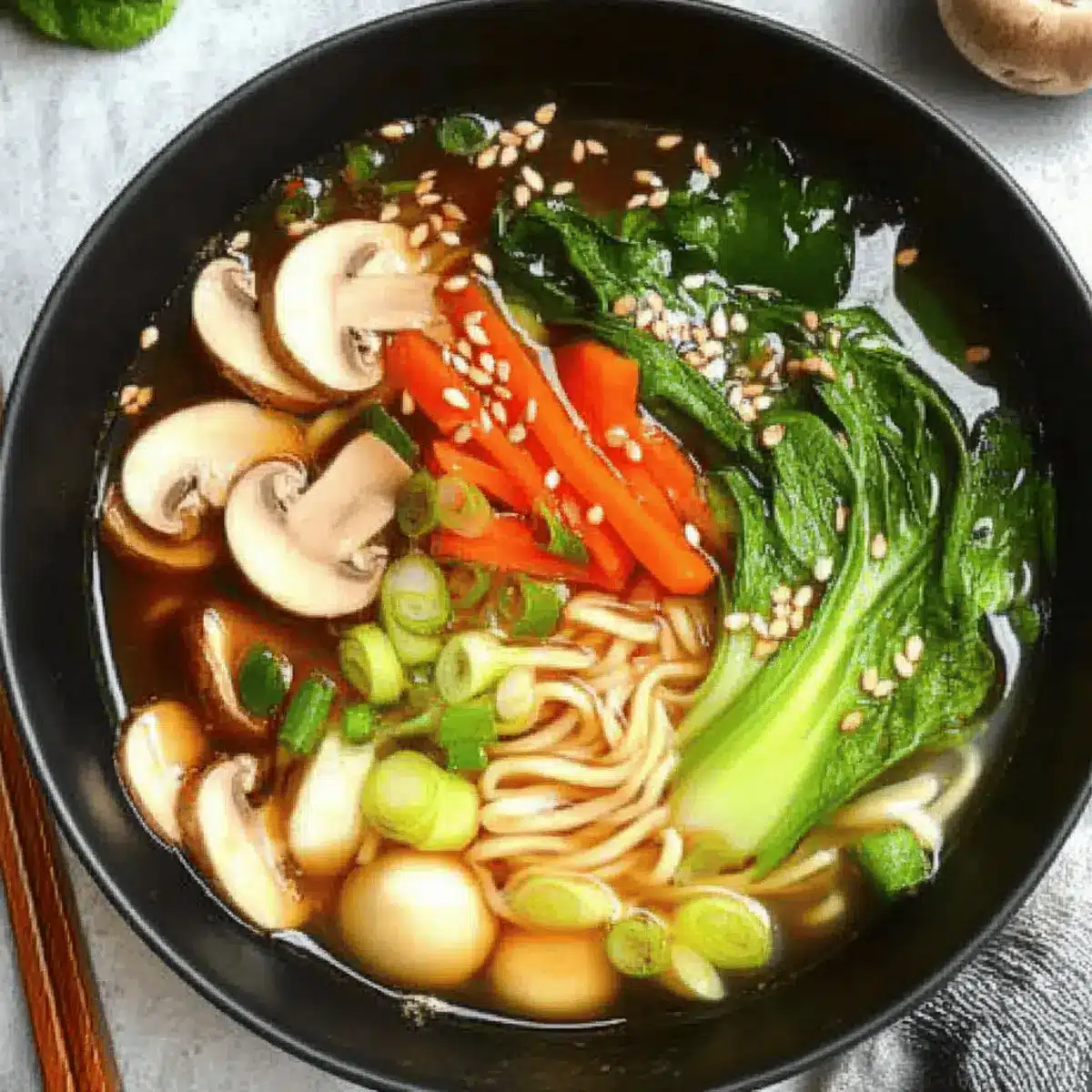As I stirred the bubbling pot of broth, the fragrant steam enveloped my kitchen like a warm hug. This Easy Homemade Ramen Noodle Soup is more than just a meal; it’s a cozy escape on a chilly evening. Packed with umami-rich flavors, this incredible Japanese noodle soup not only warms you up but also offers the flexibility to customize it to your liking, whether you crave it with tender chicken, savory mushrooms, or a vibrant mix of veggies. Plus, it’s quick to whip up, making it a perfect solution for busy weeknights when you want something heartwarming without the wait. Ready to delight your taste buds and impress your loved ones with a comforting bowl of goodness? Let’s dive into the ingredients and get cooking!

Why is homemade ramen a game changer?
Simplicity: You can whip up this delicious ramen in no time, making it an ideal choice for busy weeknights.
Customizable: With options to swap ingredients, from chicken to tofu, your ramen becomes a unique creation tailored just for you!
Flavor-Packed: Rich, umami-filled broth delivers a taste sensation that’s comparable to your favorite restaurant’s dish, all made at home.
Healthy Options: Choose lower-calorie alternatives to fit your lifestyle, ensuring you don’t have to sacrifice health for taste.
Crowd-Pleaser: This dish is sure to impress family and friends, making it perfect for gatherings. Serve it alongside an appetizer like Sticky Beef Noodles for a complete meal!
Japanese Noodle Soup Ingredients
For the Broth
• Ramen Bouillon – The soul of your soup, substitute with vegetable broth for a vegetarian option.
• Sesame Oil – Adds a nutty aroma, use olive oil for a lighter twist.
For the Toppings
• Sojaeier (Soy Eggs) – Marinated soft-boiled eggs that bring richness; swap with tofu for a vegan option.
• Hähnchen (Chicken) – Tender protein that enhances flavor; consider pork or shrimp for variation.
• Kleine Champignons (Small Mushrooms) – Provides earthy notes; try using other mushrooms or broccoli as a substitute.
• Pak Choi (Bok Choy) – Adds vibrant crunch; spinach or kale works just as well.
• Knoblauch (Garlic) – Fresh garlic deepens the flavor; garlic powder can be a quick alternative.
For the Noodles
• Ramen Nudeln (Ramen Noodles) – The heart of the dish; instant noodles or soba are good gluten-free options.
For Seasoning
• Sojasauce (Soy Sauce) – A splash adds depth; tamari is a gluten-free swap.
• Karotte (Carrot) – Brings a hint of sweetness; bell peppers or zucchini make great substitutes.
Step‑by‑Step Instructions for Easy Homemade Ramen Noodle Soup
Step 1: Prepare the Soy Eggs
Start by soft boiling the eggs in a pot of simmering water for about 6-7 minutes until the whites are set and the yolks are still creamy. After boiling, cool the eggs in cold water, then peel and marinate them in a mixture of soy sauce for at least 30 minutes. These soy eggs will add a rich umami flavor to your homemade ramen.
Step 2: Sauté the Chicken
In a large pan over medium heat, add 1 tablespoon of sesame oil and let it warm for about 1 minute. Once hot, add minced garlic and sauté for about 30 seconds until fragrant. Then, add bite-sized pieces of chicken, cooking them for about 5-7 minutes until they’re golden brown and cooked through. Set aside the chicken once done for assembling the ramen.
Step 3: Prep the Vegetables
While the chicken cooks, wash and slice your fresh vegetables: julienne the carrots, slice the mushrooms, and chop the bok choy into bite-sized pieces. Arrange these vibrant vegetables in individual serving bowls, as they’ll provide a satisfying crunch and nutrition once the hot broth is poured over them.
Step 4: Cook the Ramen Noodles
In a separate pot, bring water to a rolling boil and cook your ramen noodles according to package instructions, usually about 3-4 minutes. Once al dente, drain the noodles and run them under cold water briefly to stop the cooking process. These noodles will be the heart of your Easy Homemade Ramen Noodle Soup.
Step 5: Prepare the Broth
In the same pot used for the noodles, add the ramen bouillon and bring it to a brisk boil over high heat. Once bubbling, lower the heat and let it simmer for 2-3 minutes. This rich broth is essential to bringing together all the flavors in your Japanese noodle soup, so ensure it’s fragrant and hot when served.
Step 6: Assemble the Ramen Bowls
Carefully pour the hot broth over the vegetables in each bowl, allowing them to cook slightly in the steaming liquid. Then, add the cooked ramen noodles and sliced chicken on top. The heat from the broth will brighten the vegetables and infuse their flavors into your Easy Homemade Ramen Noodle Soup.
Step 7: Add Final Touches
Garnish each bowl with halved soy eggs, a sprinkle of chili flakes, and sesame seeds for extra flavor and texture. Let the assembled bowls sit for about 5 minutes to meld the flavors together before enjoying. This comforting Japanese noodle soup will be a delightful treat on chilly evenings!

Make Ahead Options
These Easy Homemade Ramen Noodle Soup bowls are fantastic for meal prep lovers! You can prepare the broth and soy eggs up to 24 hours in advance. Simply make the broth, let it cool, and refrigerate, ensuring to store it in an airtight container to maintain its rich flavor. The soy eggs can soak in the soy sauce overnight for enhanced taste. On the day you wish to serve, just reheat the broth, cook the ramen noodles fresh (as they taste best this way), and quickly sauté the chicken with garlic. Pour the hot broth over prepped veggies in bowls, add the noodles and chicken, and garnish for a comforting meal that feels just as special as when made fresh!
Japanese Noodle Soup Customization Ideas
Feel free to play around with these variations and make this recipe truly your own!
- Vegan: Swap the chicken for firm tofu and use vegetable broth for a comforting plant-based version. It’s just as rich and satisfying!
- Gluten-Free: Replace traditional ramen noodles with gluten-free soba noodles or rice noodles, ensuring everyone can enjoy this dish without worry.
- Spicy Kick: Add a spoonful of chili paste or fresh sliced chili to the broth for a delightful heat that elevates the whole bowl!
- Extra Veggies: Toss in a handful of spinach, snap peas, or bell peppers for an even more vibrant and nutritious bowl of soup. The more colors, the better!
- Broth Boost: For added depth, incorporate miso paste or a splash of ponzu sauce into the broth to enrich the umami flavors further.
- Savory Swap: Try using pork belly or crispy bacon instead of chicken for a richer, more indulgent flavor that takes your ramen to the next level.
- Seafood Delight: Substitute the protein with shrimp or scallops for a delightful seafood twist that pairs beautifully with the savory broth.
- Inspired with Noodles: Instead of ramen, get creative with udon or egg noodles for a different texture while still keeping the heartiness of the soup.
No matter how you decide to customize your ramen, don’t forget to enjoy a beautiful side like Taiyaki Japanese Fish for dessert! The joy of homemade ramen comes from making it distinctly yours. Happy cooking!
What to Serve with Easy Homemade Ramen Noodle Soup
Creating the perfect meal around your ramen noodle soup can transform a simple dish into an extraordinary dining experience.
-
Crispy Spring Rolls: These delightful bites offer a crunchy texture that contrasts beautifully with the warm, slurpy noodles.
-
Garlic Edamame: A light and healthy starter, vibrant edamame sprinkled with sea salt adds a pop of flavor without overpowering your soup.
-
Chili Garlic Tofu: For an extra kick, serve spicy, crispy tofu alongside your ramen. The heat complements the umami-rich broth, creating an exciting flavor combination.
-
Vegetable Tempura: The light, crispy batter enhances the fresh vegetables in your ramen while providing a fun, shareable side that everyone loves.
-
Coriander Lime Rice: This fragrant side dish, with its zesty notes, works well to round out your meal while making the flavors of the soup shine even brighter.
-
Japanese Pickles (Tsukemono): A refreshing, tangy contrast to the richness of the ramen, these pickles cleanse the palate and deepen the flavor experience.
-
Craft Beer or Green Tea: Pair your bowl of ramen with a smooth Japanese beer or a delicate green tea; both will enhance your dining experience splendidly, whether enjoyed as a refreshment or to complement the richness of the broth.
-
Chocolate Mochi: Finish your meal with these delightful Japanese rice cakes; their chewy texture and subtle sweetness make for the perfect ending to your flavorful journey.
Elevate your Japanese noodle soup with these thoughtful pairings for a wonderfully balanced meal that nourishes both body and soul!
How to Store and Freeze Japanese Noodle Soup
Fridge: Store leftover broth in an airtight container for up to 3 days. Keep cooked noodles separate to maintain their texture, as they can become mushy if mixed with the broth.
Freezer: If you want to store your ramen for longer, freeze the broth in ice cube trays or freezer-safe containers for up to 3 months. Cook fresh noodles each time you reheat the broth.
Reheating: To reheat, gently warm the broth in a saucepan until bubbling. Add freshly cooked noodles and your choice of toppings for a quick meal that tastes like a warm hug.
Expert Tips for Homemade Ramen
-
Broth Temperature: Ensure the broth is boiling hot when poured over vegetables for optimal cooking. This helps maintain a vibrant texture and flavor.
-
Slice Wisely: Thinly slice your vegetables to promote quicker cooking. This way, everything will be tender and ready to enjoy in no time!
-
Mind the Noodles: Don’t overcook the ramen noodles; they should be al dente. Running them under cold water after boiling helps maintain their perfect texture.
-
Get Creative: Feel free to experiment with toppings! Sliced green onions, nori, or a drizzle of spicy chili oil can elevate your Japanese noodle soup experience.
-
Storage Savvy: Store leftover broth in the fridge for up to 3 days, but cook fresh noodles each time for the best texture in your homemade ramen.

Easy Homemade Ramen Noodle Soup Recipe FAQs
What should I look for when selecting fresh vegetables for my ramen?
Absolutely, fresh vegetables enhance the flavor and texture of your ramen! Look for vibrant colors and firm textures; avoid any that show signs of wilt or dark spots. Carrots should be crisp, while mushrooms should be firm and free of slime. Bok choy should feel crisp, not wilted, ensuring a fresh crunch in your soup.
How should I store leftover ramen soup?
Very! To store your leftover broth, pour it into an airtight container and refrigerate for up to 3 days. If you have cooked noodles, keep them separate to prevent them from getting mushy. Reheat just the broth and cook fresh noodles each time for ideal texture.
Can I freeze the broth for later use?
You can! It’s easy to freeze your ramen broth for future meals. Pour the cooled broth into ice cube trays or freezer-safe containers, leaving some space for expansion. It can stay fresh for up to 3 months. To use, simply thaw overnight in the refrigerator or reheat directly on the stove until bubbling!
What toppings can I add to make my ramen even more flavorful?
Get creative! Consider adding sliced green onions, sheets of nori, or even a dollop of spicy chili oil for a flavor kick. A sprinkle of sesame seeds or crushed red pepper can elevate not just the taste but also the visual appeal of your ramen dish.
Can I make this recipe vegan or vegetarian?
Absolutely! To make your ramen vegetarian or vegan, substitute chicken with tofu, and use vegetable broth instead of ramen bouillon. You can enhance the umami flavor with mushrooms and soy sauce. Replace the soy eggs with marinated tofu or just skip them altogether to keep it plant-based.
What if my ramen noodles get too soggy when cooking?
No worries! To prevent soggy noodles, ensure you cook them just until al dente, usually about 3-4 minutes, and then drain and run them under cold water to halt the cooking process. This helps maintain their perfect texture, making your homemade ramen experience even better.

Delicious Japanese Noodle Soup You Can Customize at Home
Ingredients
Equipment
Method
- Prepare the Soy Eggs: Soft boil the eggs for 6-7 minutes, cool in cold water, peel, and marinate in soy sauce for 30 minutes.
- Sauté the Chicken: In a pan, heat sesame oil, add minced garlic, and sauté for 30 seconds. Add chicken pieces and cook for 5-7 minutes until golden brown.
- Prep the Vegetables: Wash and slice carrots, mushrooms, and bok choy. Arrange in serving bowls.
- Cook the Ramen Noodles: Boil water and cook ramen noodles according to package instructions for 3-4 minutes. Drain and cool briefly.
- Prepare the Broth: In the same pot, add ramen bouillon and bring to a boil, then simmer for 2-3 minutes.
- Assemble the Ramen Bowls: Pour hot broth over vegetables in each bowl, add noodles and chicken on top.
- Add Final Touches: Garnish with halved soy eggs, chili flakes, and sesame seeds. Let sit for 5 minutes before serving.

Leave a Reply